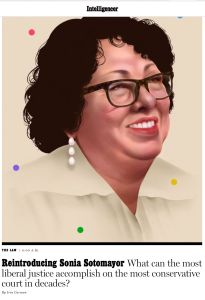
Reintroducing Sonia Sotomayor
What can the most liberal justice accomplish on the most conservative court in decades?
Recommendation
The COVID-19 pandemic didn’t make Supreme Court Justice Sonia Sotomayor’s life any simpler, Irin Carmon reports in New York Magazine. Sotomayor likes talking with her clerks. She likes being among people, and the only crowds she was in for months were at the funeral of Supreme Court Justice Ruth Bader Ginsburg and the inauguration of Joe Biden and Kamala Harris. The Justice engages in lively debate during oral arguments in the Supreme Court, which aren’t the same when they’re reduced to live-streamed phone calls. Over a decade into her tenure, Sonia Sotomayor, now 66, has become the dominant liberal voice on the Supreme Court.
Summary
About the Author
Israeli-American journalist and commentator Irin Carmon is a senior correspondent at New York Magazine and a CNN contributor. She is the co-author of Notorious RBG: The Life and Times of Ruth Bader Ginsburg.
















Comment on this summary